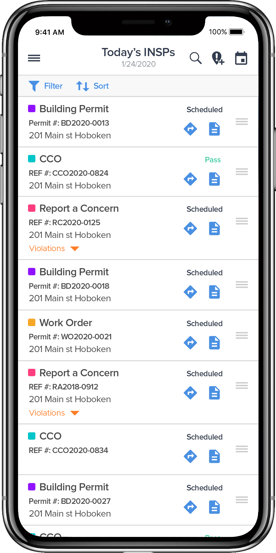For municipal governments everywhere, residential and commercial building inspections are one of the most important ways to ensure public safety and high quality of life for constituents. As the building collapse tragedy in Surfside, Florida so tragically demonstrated, failure to conduct regular site inspections, enforce building codes, and issue building permits can be deadly.
As a leader in local government, you are wise to consider how your building inspections division can keep up with development and ensure that local ordinances are being followed both in new construction and older structures. But what are the best practices for performing commercial and residential building inspections? And, as secondary cities and other local communities continue to see an influx of people moving in paired with rapid new construction, how can officials efficiently get building inspections done without sacrificing thoroughness?
Follow along for insights on all of the things your building inspectors need to do right and how modern government technology can help.
Why Are Building Inspection Services So Important?
The sad reality is that corners are cut and mistakes are made in construction all of the time. As a result, commercial buildings and residential buildings and homes may have, or develop issues that make them dangerous and compromise safety.
To make matters worse, properties that passed previous inspections can develop dangerous structural problems over time as the infrastructure, building material, and even local geology wears down.
As a result, local governments everywhere need to have a thorough and recurring building and home inspection process in place, so that dangerous issues with infrastructure - apparent or hidden - get overlooked that end up costing lives within the community. Code compliance is critical to public safety and the livability of your municipality.
How to Perform Building Inspections?
Now that you understand why your local government needs to take building inspections seriously, let’s get into the how.
It is well known that infrastructure like roads and bridges across the U.S. are aging. So too are many commercial and residential buildings that need to be thoroughly inspected. This need can strain inspection schedules, particularly if traditional paper-based inspection processes are being used. If you are a building official it might be time to consider a digital-based inspection process which can save hours of work per week and ensure that inspections are thorough and well documented. Read on to learn more.
Any building or home will have the following five major systems included, so you’ll need to take a thorough look at electrical, plumbing, ventilation, heating, and mechanical systems. Here is a building inspection checklist broken down by each major system.
How to Inspect Electrical Systems?
Here are the major electrical components your building inspectors should be looking out for during electrical inspections:
-
Electrical systems that are running properly without compromising safety.
-
Ensuring the proper wiring is used throughout the property. Aluminum and other dated wiring systems are no longer the best or safest to use.
-
Review of the fuses and breakers to check for proper sizing.
-
Review of any work done by electricians and contractors since the last inspection.
-
Review plans and issue electrical permits for any proposed new work.
How to Inspect Plumbing?
Here are the things you should be inspecting related to plumbing and water systems:
-
Ensure that internal water sources like sinks, tubs, toilets, and water pipes have water flowing smoothly.
-
Check that external sources like pipes and hydrants are running smoothly and not leaking.
-
Check that anti-freeze precautions are implemented to prevent frozen pipes and other issues.
-
Review the water temperature and test the pipes and relief valves of the water heaters.
-
Check that concrete around pipes, in foundation, and in structural supports is intact and not showing signs of stress like cracking caused by leaking water or shifting sediment.
-
Review commercial plans of underground plumbing or electrical systems prior to any planned excavation.
How to Inspect HVAC (Heating & Ventilation)?
Here are the processes for inspecting air conditioning and ventilation systems:
-
Check for debris blocking ventilation systems, and chimneys which can pose a major fire or Carbon Dioxide risk.
-
Test the thermostat to make sure it is functioning and adjusting temperatures accordingly.
-
Make sure that filters are not out of date and have been / will be replaced.
-
Check that the HVAC unit is level and not causing the compressor to fail.
-
Review the fins inside the ventilation unit, evaporator coil, and evaporator drain to make sure they’re clean and functional.
-
All radiators and vents should be reviewed to ensure they function properly and don’t pose a fire risk.
As far as the mechanical systems inspection, major components from each of the aforementioned systems fall into this bucket as well, like the thermostat, ventilation systems, and electrical systems. Be thorough and make sure that anything leveraging electricity is using modern, up to code technology that functions properly!
Consider other factors such as surrounding development and geologic factors like salt water spray, sea level rise, and sediment shift to determine whether inspections should be conducted more frequently or if building codes need to be made more strict.
How Can Local Governments Handle the Increasing Demand for Building Inspections?
As construction continues to boom with shifting populations across the country, your building inspectors may be feeling more stressed than ever. The loss of life from the building collapse outside of Miami, and other near catastrophes like a massive crack found in a Memphis bridge have been a wake up call for many of the dangers that aging physical infrastructure poses for the safety of our communities.
 As a result, it is wise to consider recruiting government workers to increase the number of inspections being done daily. More building inspectors will ensure that no property within your jurisdiction gets overlooked or inspections are rushed, so that no one needs to fear that the place they live in will put them in danger.
As a result, it is wise to consider recruiting government workers to increase the number of inspections being done daily. More building inspectors will ensure that no property within your jurisdiction gets overlooked or inspections are rushed, so that no one needs to fear that the place they live in will put them in danger.
If you’re still using antiquated paper-based inspection processes, you should also consider leveraging cloud-based building inspection software to expedite the time it takes to perform inspections while simultaneously improving the inspection quality.
Here’s how building inspection software will improve your processes and enable inspectors to conduct more inspections per week:
-
Provide inspectors with an easy to navigate mobile application: your building inspectors no longer need to manually write everything down on piece of paper and clipboard, only to drive back to the office to re-enter information into a spreadsheet. The GovInspect mobile application provides digital inspection processes that can be used to tick every box and take notes on every facet of an inspection.
-
GovInspect is cloud-based: every entry is saved from the field directly into the GovPilot platform, enabling colleagues back at the office or working remotely to access and view records in real time. No more time wasted driving back to the office or doing manual data entry. With GovPilot's GovInspect, you'll instantly have property and inspection history easily accessible across departments.
-
Automated assignments and scheduling: If your inspector is constantly waiting on call for their next assignment, or having to return to the office to update their schedule, chances are they’re not not conducting as many inspections as they could be. With GovInspect, government leadership can assign inspections across departments like planning and zoning, code enforcement, and building and construction. Once inspections are assigned, your inspectors will be alerted and have a clear layout of everywhere they need to be throughout the day. You can also track progress to ensure the inspectors are working to the best of their capabilities and completing their assigned tasks.
-
Issuance of violation citations: in the case that a building is not up to code or a violation is found, inspectors can decline to issue a certificate or permit, and instead send a digital citation via the cloud-based system, enabling the property owner to address the citation and pay any fines or fees online. Automated records will notify the building and construction department of the citation and reschedule a follow up inspection to ensure that the cited issue is resolved so that a certificate can be presented.
-
Issuance of permits and certificates of occupancy: with GovInspect, inspectors can charge permit fees, issue permits, and greatly reduce the actual time of inspection. In fact, see how inspectors from Trenton, New Jersey saved 100 hours per week with GovInspect.
In Conclusion
Overall, the need for thorough building inspections is more critical than ever before. With ever increasing new construction and aging infrastructure, the demand and need for building inspections new and old is clear. To keep pace, not only should inspectors in your municipality have the know-how to inspect all five of the major systems within a property, the should also be equipped with modern government digital technology in order to keep citizens safe and city hall ahead of possible tragedy.
To learn more about how building inspection software can help your community to get inspections done, schedule a consultation.
Building Inspections FAQ
1. Why are building inspections critical?
Building inspections are critical for the health and well being of occupants and those who live in and around structures. From residential homes to high-rise office towers. The sad reality is that corners are cut and mistakes are made in construction all of the time. As a result, commercial buildings and residential buildings and homes may have, or develop issues that make them dangerous and compromise safety.
To make matters worse, properties that passed previous inspections can develop dangerous structural problems over time as the infrastructure, building material, and even local geology wears down. Building inspections ensure that structures are safe to occupy.
2. Why is demand increasing for building inspections?
Demand is increasing for building inspections because the pace of new development is increasing, and existing structures continue to age while still being heavily used. Human factors like physical disruption from new development and environmental factors like sea level rise and flooding can impact the safety and integrity of existing structures.
New construction must be inspected to ensure it meets building code and is built according to its approved plan and will not disrupt existing infrastructure like buried water, electric, or gas lines.
3. How can building officials meet the demand for increasing inspections?
Building and code enforcement officials should consider adopting modern building inspection software and code enforcement software which is cloud-based and mobile compatible. This will enable inspectors to be more thorough while allowing them to save time by eliminating manual data entry and travel back to the office. This time savings well enable inspectors to conduct more site visits and certify the safety of more buildings each week.










